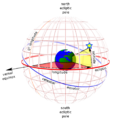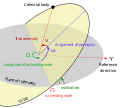The equatorial coordinate system is a celestial coordinate system widely used to specify the positions of celestial objects. It may be implemented in...
17 KB (1,657 words) - 07:37, 20 March 2025
object's location expressed in the equatorial coordinate system can be transformed into the galactic coordinate system. In these equations, α is right ascension...
15 KB (1,383 words) - 10:24, 1 August 2024
In astronomy, the ecliptic coordinate system is a celestial coordinate system commonly used for representing the apparent positions, orbits, and pole orientations...
14 KB (1,331 words) - 02:25, 16 December 2024
position of stars relative to an observer's ideal horizon. The equatorial coordinate system is centered at Earth's center, but fixed relative to the celestial...
29 KB (3,971 words) - 18:25, 17 April 2025
Earth's equatorial region tropical climate the Celestial equator equatorial orbit equatorial coordinate system equatorial mount, of telescopes equatorial bond...
444 bytes (84 words) - 10:11, 21 December 2022
A geographic coordinate system (GCS) is a spherical or geodetic coordinate system for measuring and communicating positions directly on Earth as latitude...
23 KB (2,540 words) - 22:18, 14 May 2025
Right ascension (category Astronomical coordinate systems)
specify the location of a point on the celestial sphere in the equatorial coordinate system. An old term, right ascension (Latin: ascensio recta) refers...
14 KB (1,371 words) - 01:10, 25 October 2024
right ascension (α) and declination (δ). This pair based the equatorial coordinate system. While δ is given in degrees (from +90° at the north celestial...
4 KB (391 words) - 14:04, 5 April 2025
Equatorial Coordinate System), the direction cosine vector of the orbiting body from the observation points (from Topocentric Equatorial Coordinate System)...
15 KB (2,829 words) - 06:02, 6 February 2025
In mathematics, the polar coordinate system specifies a given point in a plane by using a distance and an angle as its two coordinates. These are the...
49 KB (6,702 words) - 21:47, 13 May 2025
is a Cartesian coordinate system (x, y, z). The equatorial coordinate system uses the celestial equator. The ecliptic coordinate system uses the ecliptic...
2 KB (178 words) - 15:13, 9 January 2025
astronomy are celestial coordinate systems and time. The coordinates of objects on the sky are listed using the equatorial coordinate system, which is based on...
6 KB (662 words) - 17:07, 22 October 2023
The perifocal coordinate (PQW) system is a frame of reference for an orbit. The frame is centered at the focus of the orbit, i.e. the celestial body about...
6 KB (1,037 words) - 03:50, 27 January 2025
A near-equatorial orbit is an orbit that lies close to the equatorial plane of the primary body orbited. Such an orbit has an inclination near 0°. On Earth...
5 KB (689 words) - 18:00, 15 March 2025
The supergalactic coordinate system is a reference frame for the supercluster of galaxies that contains the Milky Way galaxy, referenced to a local relatively...
7 KB (927 words) - 03:24, 17 July 2024
The horizontal coordinate system is a celestial coordinate system that uses the observer's local horizon as the fundamental plane to define two angles...
9 KB (944 words) - 04:39, 7 January 2025
A planetary coordinate system (also referred to as planetographic, planetodetic, or planetocentric) is a generalization of the geographic, geodetic, and...
19 KB (2,166 words) - 18:42, 29 March 2025
ISBN 0-7506-6169-0. Retrieved 2023-01-08. Xu, Guochang; Xu, Yan (2016). "Coordinate and Time Systems". GPS. pp. 17–36. doi:10.1007/978-3-662-50367-6_2. ISBN 978-3-662-50365-2...
6 KB (833 words) - 11:13, 26 March 2025
Low Earth orbit (redirect from Equatorial Low Earth Orbit)
altitudes below 300 km (190 mi) decay quickly due to atmospheric drag. Equatorial low Earth orbits (ELEO) are a subset of LEO. These orbits, with low orbital...
19 KB (2,117 words) - 21:11, 17 March 2025
Hour angle (category Astronomical coordinate systems)
specify the location of a point on the celestial sphere in the equatorial coordinate system. The local hour angle (LHA) of an object in the observer's sky...
6 KB (676 words) - 15:20, 16 April 2025
was used. The World Geodetic System WGS84 ellipsoid is now generally used to model the Earth in the UTM coordinate system, which means current UTM northing...
18 KB (2,858 words) - 13:14, 29 May 2025
Declination (category Astronomical coordinate systems)
two angles that locate a point on the celestial sphere in the equatorial coordinate system, the other being hour angle. The declination angle is measured...
12 KB (1,187 words) - 11:39, 18 February 2025
telescope equipped with a properly aligned equatorial mount, the observer may also follow the equatorial coordinate system on a star map to "hop" or "slide" along...
3 KB (410 words) - 02:45, 4 January 2024
is an event, defined only when using either an equatorial or an ecliptic celestial coordinate system, in which any two astronomical objects (e.g. asteroids...
25 KB (144 words) - 00:30, 7 December 2024
eccentricity vector (a vector pointing towards the periapsis). In the case of equatorial orbits (which have no ascending node), the argument is strictly undefined...
4 KB (565 words) - 00:23, 24 September 2024
Celestial sphere (category Astronomical coordinate systems)
building a system that way are as much historic as technical. Astronomy portal Horizontal coordinate system Equatorial coordinate system Hour angle Pole...
18 KB (2,222 words) - 09:05, 1 May 2025
orbit. However, a synchronous orbit need not be equatorial; nor circular. A body in a non-equatorial synchronous orbit will appear to oscillate north...
5 KB (657 words) - 09:36, 29 May 2025
vehicle to launch a given payload to a given altitude than for a near-equatorial orbit at the same altitude, because it cannot take advantage of the Earth's...
11 KB (1,231 words) - 04:17, 22 May 2025
Geostationary orbit (redirect from Geosynchronous equatorial orbit)
A geostationary orbit, also referred to as a geosynchronous equatorial orbit (GEO), is a circular geosynchronous orbit 35,786 km (22,236 mi) in altitude...
49 KB (4,893 words) - 06:24, 20 May 2025
Position of the Sun (category Dynamics of the Solar System)
position in the ecliptic coordinate system, convert to the equatorial coordinate system, and convert to the horizontal coordinate system, for the observer's...
25 KB (3,398 words) - 22:39, 16 April 2025





















